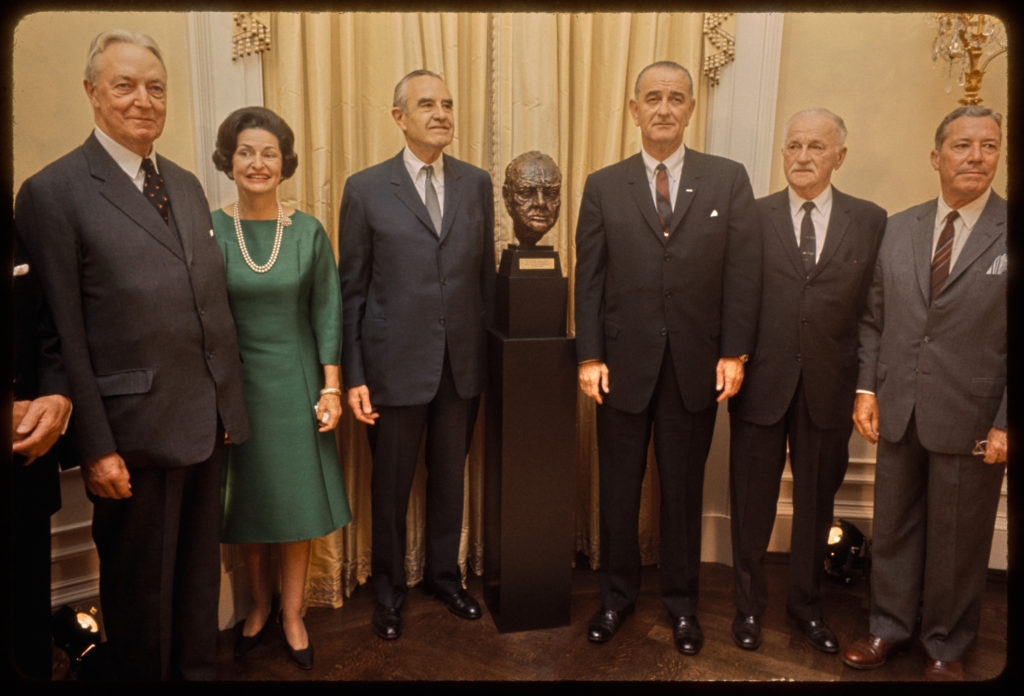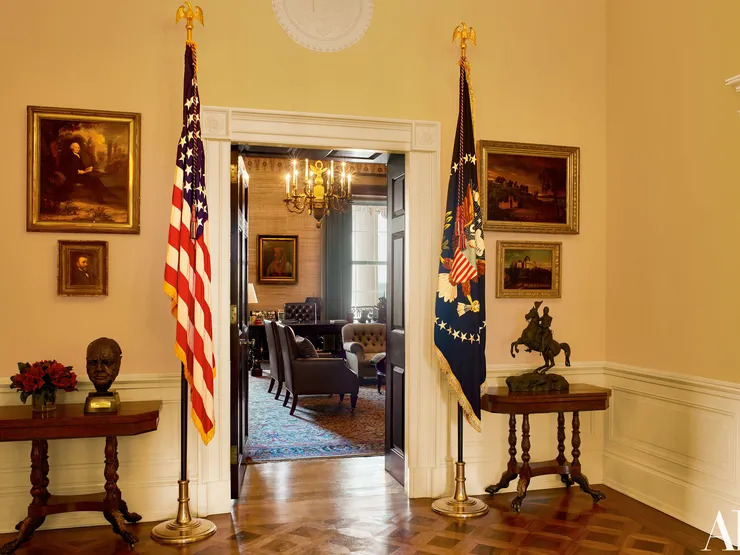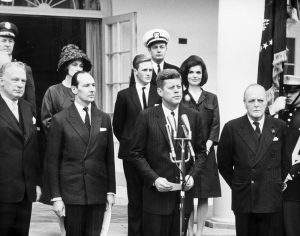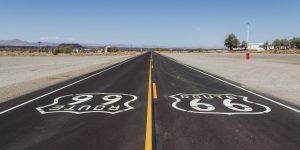
Finest Hour 192
The White House Bronze: President Lyndon B. Johnson Welcomes Winston’s Wartime Friends to Washington

Presentation ceremony, October 1965. Photo: White House Historical Association.
December 15, 2021
Finest Hour 192, Second Quarter 2021
Page 25
By Angela Baker
Angela Baker graduated from the George Washington University in 2020 with a degree in English and History, with a specialization in military history.
For more than fifty-five years a bust of Winston Churchill has been part of the permanent collection of the White House. An identical bust owned by the British Embassy in Washington has twice been loaned in the present century to American presidents for display in the Oval Office, resulting in a minor stir each time the bust was properly returned following the terms of the loan. Lost amid the roar has been the story of the bust that always remains, a story told here by a promising young scholar and recipient of the 2020 National Churchill Leadership Center Undergraduate Research Fellowship.
One October evening in 1965, a gathering at the White House brought about the reunion of several wartime figures, or “wartime friends,” to honor Sir Winston Churchill. Though the former prime minister had died the previous January, this assembly of the great and the good, all famed in their own right, were set to celebrate Churchill’s legacy and the bonds he helped to shape between the nations represented by those in attendance.1
The purpose of the event was the presentation to the White House permanent collection of a bust of Churchill, which had been donated by some of these same wartime friends now present. The bust is one of several bronze castings made by Jacob Epstein in 1947. This generous gift was a symbol of the bonds between the United Kingdom and the United States and the man who had inspired the people of both nations during the Second World War.2

2025 International Churchill Conference
The Guests
President Lyndon B. Johnson and First Lady Lady Bird Johnson presided at the ceremony. Over the years, President Johnson had had various encounters with Churchill. LBJ was in Congress when Churchill spoke to both houses in 1941, 1943, and 1952. Churchill also visited Washington while LBJ was Senate Minority Leader in 1954 and Majority Leader in 1959. Lady Bird greatly admired Churchill and was eager to attend the dedication ceremony for sentimental reasons. She was particularly fond of several of the wartime friends, most notably Averell Harriman.3
The idea for the donation of the bust was, according to Lady Bird, originally Harriman’s. He had served as the United States Ambassador to the Soviet Union from 1943 until April 1946 and then as the Ambassador to the United Kingdom from April to October of that year. To many, including Lady Bird, Harriman seemed indestructible, still handsome in his mid-seventies and continuing to lead an active life in the political sphere. With decades of dedication to serving the country in whatever role he was placed, Harriman had a reputation for getting things done and being a good friend. He was revered by the Johnsons as well as by the Roosevelts and Churchills.4
In addition to Harriman, a host of ambassadors and generals who helped shape the course of the Second World War were also in attendance at the White House ceremony, including three senior airmen: General Carl Spaatz, who had been sent as a special military observer to the Battle of Britain in 1940 and went on to become the commanding general of the United States Army Air Corps in the European Theater throughout the war; General Ira Eaker, who had served as the commander of all US Army Air Forces in the United Kingdom; and Frederick Anderson, who had served as the commanding general of the Eighth Bomber Command in the European Theater. Anderson flew from Europe to attend the event.5
Former President (and by act of Congress once again known as “General”) Eisenhower, though unable to attend, sent a sweet, personal note. Throughout the war, Churchill and Eisenhower had developed a close relationship as they collaborated to plan the invasions of North Africa, Italy, and France. Though they did not always agree, the pair always viewed one another with profound respect.6
Some of the most famous war correspondents had also been invited. Although Edward R. Murrow had died three months after Churchill, Murrow’s widow Janet was in attendance. Also present was Bill White, who had served in England as a war correspondent before and after D-Day and of whom Lady Bird remarked that there was “no greater admirer of Winston Churchill.” Eddie Folliard was there as well, having covered seven Presidents during his tenure as a White House correspondent for the Washington Post, starting in 1923. Alistair Cooke, a British-born American writer and journalist, captured the essence of the event perfectly as the embodiment of the intersection between two nations. Kay Halle, another journalist, had served as an intelligence officer during the war. She not only campaigned for both Presidents Roosevelt and Kennedy; she was also the driving force behind getting the legislation passed to award Churchill honorary American citizenship in 1963 (see p. 24).7
Children of many of the great war figures who had since died attended in place of their parents. Anna Roosevelt Halsted, the daughter of President Franklin D. Roosevelt, brought her husband Dr. James Halsted. The Halsteds were joined by Anna’s younger brother, Franklin D. Roosevelt Jr. Diana Hopkins Baxter, the daughter of FDR’s personal advisor Harry Hopkins, was also there, though Lady Bird mistakenly identifies her as “Anna” in her writing about the ceremony. Contributing to the nostalgia of the evening, Lady Bird described to Diana how a picture of her as a young girl with her father and FDR had hung on President Johnson’s walls during the time he was in the House of Representatives. There was also one very special representative of the Churchill family.8
Guest of Honor
The guest of honor at the ceremony was Winston Spencer Churchill, the grandson of Sir Winston. Accompanying him was his wife Minnie. The pair were on a lecture tour of America, which took them to forty-seven cities in fifty days. The opportunity to attend the dedication ceremony was a diversion they could hardly pass up. Minnie remembers how mesmerized she was on her first visit to the White House: “The White House was looking so elegant and beautiful, as it had been redecorated by Jackie Kennedy.”9
The interior of the White House had undergone an acclaimed transformation under the direction of Jackie Kennedy, which began in 1961 and had lasted throughout the entirety of her husband’s presidency. At the ceremony, Lady Bird remarked on what a “superb job” the former First Lady had done in redecorating. Though the current First Lady and President Johnson had occupied the White House for nearly two years, she noted that everything in the White House was “95 percent as [Jackie] had left it.”10
After the presentation of the bust by Averell Harriman, President Johnson spoke briefly, and so did Sir Patrick Dean, one of the many ambassadors present, who had been the British Ambassador to the United States since April. After Ambassador Dean, Lady Bird took the opportunity to express herself, feeling moved to speak by her own passion, rather than “dragged by duty.” She then called upon Winston to say a few words in memory of his grandfather.11
Though he may have been caught off guard, the young Churchill, bolstered by the confidence he had gained over the course of his lecture tour, was able to improvise a speech thanking the wartime friends for honoring his grandfather. Lady Bird noted how “pink-cheeked” and “youthful” he was, in particular when compared to the other attendees of the reception.12
Following the official ceremony, the evening continued for some in various ways. Winston and Minnie dined with Kay Halle and Alistair Cooke as guests of David Bruce, another ambassador, at the Metropolitan Club, located a short distance from the White House.13
Tangled Loves
While the event had brought about the reunion of wartime friends, it also brought about the reunion of several wartime romances. During the war, Harriman had an ongoing affair with Pamela Churchill, the wife of Randolph Churchill and mother to young Winston. Though in 1965 he was married to his second wife, Marie Norton Whitney, Harriman eventually married Pamela in 1971 after Marie’s death. For Minnie, the presentation of the bust was “the first time I met Averell Harriman and, little did I realize, that a few years later, my mother-in-law, Pamela Hayward, was going to marry Averell Harriman.”14
Though not at the presentation of the bust, Kathleen Harriman, Averell’s youngest daughter, had become romantically involved during the spring of 1942 with Franklin D. Roosevelt Jr., who was at the ceremony. At the time, FDR Jr. had been married to Ethel du Pont, a member of the prominent “chemical” family. Throughout the war, Kathleen Harriman was also doted on by General Ira Eaker, who often sent her letters and gifts.15
While her father served as US Ambassador to the UK, Kathleen, or Kathy, had been in London working as a journalist. During this time, she became close to the Churchill family and considered them among her dearest friends, particularly Pamela Churchill, who ultimately become Kathy’s stepmother when she married Averell.16
Pamela’s past lovers had also included Frederick Anderson and Edward R. Murrow. With Murrow’s widow in the room, the presentation of the bust, an event to honor Pamela’s former father-in-law, also saw three of Pamela’s most famous lovers and her son gathered together in the same place: Harriman, Anderson, and—symbolically—Murrow. Anderson and Harriman had also both been in attendance at the Yalta Conference in February 1945, along with Kathy Harriman and Anna Roosevelt.17

Kay Halle provided another romantic link between the Harrimans and the Churchills. Halle was a life-long friend of the Churchill family and wrote several books on both Sir Winston and his son Randolph, the father of young Winston. Randolph and Halle had a close personal relationship, which culminated in a proposal in 1931. Halle had also had an affair with Averell Harriman, while he was serving as United States Secretary of Commerce. During the course of the affair, he too had proposed to Halle.18
In addition to the wartime fling between FDR Jr. and Kathy Harriman, the Roosevelt children provided another romantic link to the mass of overlapping and complex connections. After the death of Anna Roosevelt Halsted, her widower James married Diana Hopkins, another of those present at the presentation of the bust.19
This group, romantically intertwined many times over, was either directly responsible for, or somehow related to the makers of, many of the key decisions that were crucial to both the outcome of the war and the rebuilding of the world thereafter.
Enduring Legacy
The presentation of the bust brought about the reunion of some of the most prominent British and American figures of the war. That a mere sculpture in bronze could achieve this demonstrated the lasting legacy of Sir Winston Churchill. Just as the award of American citizenship to Sir Winston had been a symbol of the adoration and love held for him by many Americans, the bust has become a permanent White House reminder of that same spirit.
Many at the ceremony regarded Churchill as the gold standard for political leadership. In earlier years, when President Kennedy sent then-Vice President Lyndon Johnson to South Vietnam, Johnson met with President Ngo Dinh Diem and praised him as “the Winston Churchill of Southeast Asia.” Whether or not LBJ truly believed this is not so important as the fact that the expression of association with Churchill’s name was meant to express American faith in Diem.20 Later, when President Johnson was leading his nation through the Vietnam War, he instructed his speechwriters to educate themselves about Churchill and his rhetoric. To Johnson, Churchill’s remarkable example as a wartime leader seemed to provide a model for the American president to follow. The Churchill bust on permanent display in the White House has also served to provide inspiration to all of Johnson’s successors.21
Endnotes
1. Lady Bird Johnson, A White House Diary (New York: Holt, Rinehart and Winston, 1970), p. 327.
2. “Jacob Epstein,” War Artist Archive, Imperial War Museum, accessed March 9, 2021, https://www.iwm.org.uk/collections/item/object/1050000870.
3. “Audio diary and annotated transcript, Lady Bird Johnson, 10/6/1965 (Wednesday),” LBJ Presidential Library, accessed March 9, 2021, https://www.iwm.org.uk/collections/item/object/1050000870.
4. Lady Bird Johnson, “Audio diary and annotated transcript, Lady Bird Johnson, 10/6/1965 (Wednesday)”; Lady Bird Johnson, A White House Diary, p. 327.
5.“General Carl A. Spaatz,” US Air Force, accessed March 9, 2021, https://www.af.mil/About-Us/Biographies/Display/Article/105528/general-carl-a-spaatz/; “General Ira C. Eaker,” US Air Force, accessed March 9, 2021, https://www.af.mil/About-Us/Biographies/Display/Article/107172/general-ira-c-eaker/; “Major General Frederick Lewis Anderson Jr.,” US Air Force, accessed March 9, 2021, https://www.af.mil/About-Us/Biographies/Display/Article/107839/major-general-frederick-lewis-anderson-jr/.
6. Lewis E. Lehrman, “The Prime Minister and the General: Churchill and Eisenhower,” Finest Hour, no. 2 (Spring 2016), p. 15.
7. “Oral History Interview with Edward T. Folliard,” Harry S. Truman Library, accessed March 12, 2021, https://www.trumanlibrary.gov/library/oral-histories/folliard; “Administrative Information,” Kay Halle Personal Papers, John F. Kennedy Presidential Library and Museum, accessed March 12, 2021, https://www.jfklibrary.org/asset-viewer/archives/KHPP; Lady Bird Johnson, “Audio diary and annotated transcript, Lady Bird Johnson, 10/6/1965 (Wednesday).”
8. Lady Bird Johnson, “Audio diary and annotated transcript, Lady Bird Johnson, 10/6/1965 (Wednesday).”
9. Minnie d’Erlanger Churchill, telephone interview with author, February 1, 2021; Winston S. Churchill, Memories and Adventures (New York: Weidenfeld and Nicholson, 1989), p. 189.
10. “The White House Restoration,” John F. Kennedy Presidential Library, accessed March 16, 2021, https://www.jfklibrary.org/learn/about-jfk/jfk-in-history/the-white-house-restoration; Lady Bird Johnson, A White House Diary, p. 327.
11. Lady Bird Johnson, “Audio diary and annotated transcript, Lady Bird Johnson, 10/6/1965 (Wednesday)”; Lady Bird Johnson, A White House Diary, p. 327; Winston S. Churchill, Memories and Adventures, p. 189; “Ambassador to the United States,” National Archives, accessed March 16, 2021, https://www.archives.gov/files/declassification/iscap/pdf/2015-056-doc01.pdf.
12. Lady Bird Johnson, “Audio diary and annotated transcript, Lady Bird Johnson, 10/6/1965 (Wednesday)”; Lady Bird Johnson, A White House Diary, p. 327; Winston S. Churchill, Memories and Adventures, p. 189.
13. Winston S. Churchill, Memories and Adventures, p. 189.
14. Catherine Grace Katz, The Daughters of Yalta (New York: Houghton Mifflin Harcourt, 2020), p. 96.
15. Katz, The Daughters of Yalta, pp. 17, 20; Frank Costigliola, “Pamela Churchill, Wartime London, and the Making of the Special Relationship,” Diplomatic History 36, no. 4 (2012), pp. 753–62. Accessed March 20, 2021, http://www.jstor.org/stable/44376171.
16. Katz, The Daughters of Yalta, pp. 17, 92–93.
17. Frank Costigliola, “Pamela Churchill,” p. 753.
18. Christopher Ogden, Life of the Party (Canada: Little, Brown & Company, 1994), p. 333.
19. Douglas C. McGill, “Dr. James A. Halsted, 78, A Nutrition Researcher,” The New York Times, March 6, 1984, https://www.nytimes.com/1984/03/06/obituaries/dr-james-a-halsted-78-a-nutrition-researcher.Html.
20. Michael P. Riccards, “Waging the Last War: Winston Churchill and the Presidential Imagination,” Presidential Studies Quarterly, Vol. 16, no. 2 (Spring 1986), p. 220.
21. Michael P. Riccards, “Waging the Last War,” pp. 220–21.
Subscribe
WANT MORE?
Get the Churchill Bulletin delivered to your inbox once a month.





